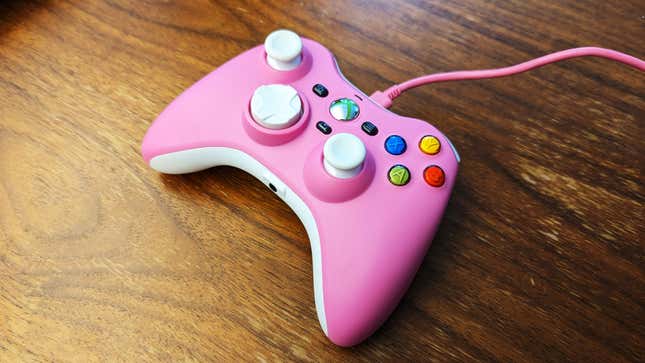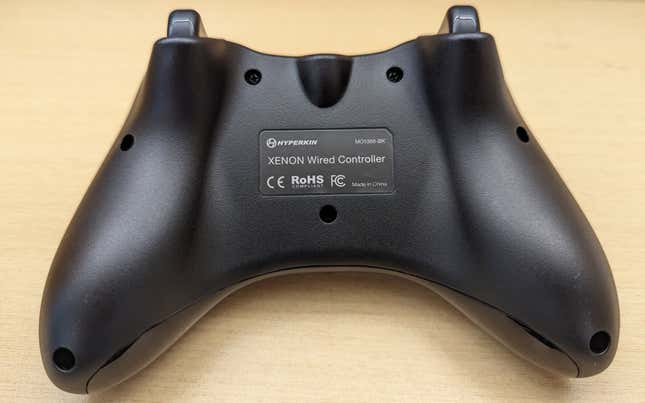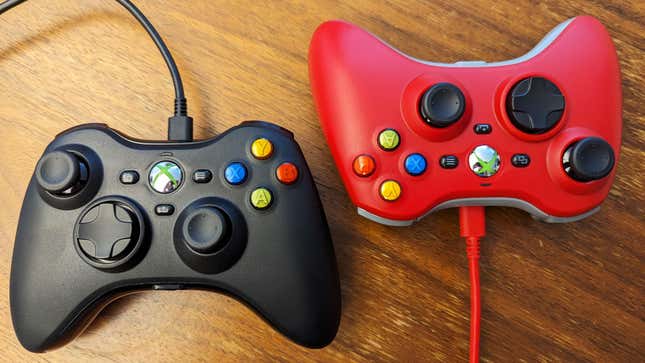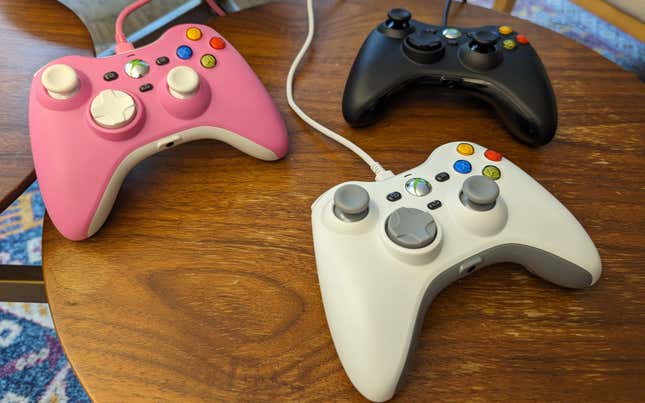
The Xbox’s gamepad wasn’t a hit right out of the gate. The original console’s first controller, often nicknamed “the Duke” for its comically large size, is remembered for just that: being enormous. Its followup, the “Controller S,” was serviceable but not particularly notable.
But when Microsoft took its third stab at introducing a gamepad, it arguably struck gold. And now, like the Duke before it, the Xbox 360 controller has returned by way of Hyperkin’s officially licensed replica for PC and modern Xbox consoles, aptly named “Xenon,” after the Xbox 360’s processor. The result is an excellent controller with generous haptic response and solid build quality. It’s the return of an old friend for sure, but one whose price and missing features make it hard to recommend over a modern Xbox Wireless controller.
The return of a proven design
The Xbox 360’s controller felt great in the hands, wisely relegating the “black and white buttons” to the shoulders, where they served as bumpers typically actuated by the sides of your index fingers, freeing up your actual fingers for use on triggers. It made shooters more enjoyable and avoided the sort of fork grip of index and middle fingers usually required for PlayStation gamepads. And on PC, Xbox 360 controllers often worked more seamlessly via XInput than something like a DualShock 3, which usually required additional software.
The Xbox One and current wireless controllers have since replaced the 360, particularly as Microsoft no longer makes the 360 controller. And the current offering from Microsoft is both affordable and of great quality. So what are the advantages of the Xbox 360 gamepad in 2023?
After spending the last two weeks primarily gaming on the Xenon on PC across a wide variety of genres, I’m happy to say that the comfort of this gamepad isn’t just nostalgia: This is a genuinely comfortable controller that feels better now that it doesn’t have the big battery pack that used to sit in the middle of the original. That extra space comes at the cost of wireless functionality, much like the original 360’s wired variant.
But if the lack of wireless isn’t an issue for you, the Xenon feels less like a dated throwback than a rather modern option. The buttons are where they’re supposed to be and it’s as comfortable as the Xbox Wireless controller. In fact, I prefer the feel of the Xenon a bit more than the Xbox Wireless controller. I’ll address its shortcomings in a moment, but when playing recent releases on PC, I’m beginning to favor the Xenon over the modern Xbox controller, and not just for the shape alone.

A refreshing feel, thunderous rumble, and old-school vibes
The first thing that stood out to me when I picked up the Xenon were the feel and motion of the analog sticks, which lack the rigid tire-like texture that lines the edges of current Xbox controllers. While I have some concern that they will eventually get worn down and become slippery, the movement of the sticks feel as though they’re looser—in a good way.
The motion of the Xenon’s thumbsticks feel flexible rather than worn in, and they seem to have a greater travel distance than the current Xbox controller. They feel good to move around, and I particularly enjoyed their looser movement while playing Diablo IV. And, as should be of no surprise, it felt so right with old-school Halo games.
All of the buttons have a satisfying action to them; the menu buttons are noticeably snappier than they were on the original (though the big X button in the center is a little spongey, which sadly doesn’t have four glowing rings around it). Same goes for the bumpers, which are almost so satisfying to click that I think I’m missing out on not dedicating fingers to them. (Yes, I know I’m weird).
Oh, but what about that d-pad? I’m not going to defend the Xbox 360 d-pad here. But I am going to say that the Xenon offers one of the best iterations of what this design could be. Were this not a replica controller, I would argue for redesigning the d-pad altogether, but it does feel snappier than the original. You won’t catch me playing Street Fighter 6 with this, but it will make for an acceptably average d-pad experience on games that don’t require heavy use of such a thing.
The triggers, which are far more narrow than what you’d have on almost any modern controller, also feel particularly at home for shooters. They resemble real gun triggers far more than what’s on the standard Xbox controller. That said, I didn’t enjoy that feeling for racing games, where the more narrow pressure against my index finger, since there’s less surface area, didn’t feel as nice.

But perhaps my favorite feature is the rumble. God does this thing feel great when it vibrates. Explosions have a nice kick and gunfire rumbles in my hand and gives me absolute joy. Sure, more contemporary haptic vibration methods like what’s in the PlayStation 5’s DualSense are nice, but offset weights spinning on motors in a plastic case is a kind of fun that I don’t think will ever get old. The rumble feels stronger than what the Xbox Wireless controller delivers, though that’s a hard metric to measure precisely.
Also, the buttons are fully colored coded. That may not seem like an obvious advantage, but consider that the standard Xbox Wireless controller only colors the letters on the buttons, and for the fancier editions, they’re all uniformly muted. Video games are meant to be fun, and it’s nice to see fun colors on a gamepad. I primarily played on a black Xenon controller, and having the yellow, red, green, and blue jewel buttons pop made me feel like I was picking up something exciting to play, not an attempt at trying to look industrial or utilitarian.

The Xenon comes in black, pink, white, and red. Each with matching colored USB cables. The red is the only odd one as it has gray sides and triggers, which is kind of an eyesore. Meanwhile, the white is very faithful to the launch 360 model (though the black menu buttons sort of mar that). That leaves the pink and black as probably the best of the current Xenon color offerings.
At $50, the wired Xenon nearly competes with the Xbox Wireless controller
How much do you value nostalgia? Because when it comes to Xenon, you’re gonna need to keep that in mind. At MSRP, the Xenon controller is $10 less than a standard Xbox wireless controller (which starts at around $60 and goes up for limited edition colors). But if you shop at Amazon or most online retailers (including directly from Microsoft’s store), it’s not uncommon to find a standard Xbox gamepad for $10 off, meaning that the Xenon and Xbox Wireless Controller are often the same price.
If the Xbox 360 controller was your jam and you don’t care about wireless, the answer’s probably clear: This is a faithful recreation and an excellent execution of the form factor.
Personally? Wires don’t bother me. I’m often within three feet of my PC tower and less than that when on my laptop, so a wire is fine for me. Still, you may differ on that, especially if you’re a console player. In that case, even the 10 ft. USB-C cable that comes with the Xenon might not be enough—and it’s not quite cheap enough to be the dedicated “I-don’t-care-what-happens-to-this-here-player-2” gamepad you fish out of a drawer when you’re labored with company who want to game.

Even though it doesn’t bother me, the lack of wireless is a friggin’ buzzkill. And that ain’t really Hyperkin’s fault. As was the case with the replica of the Duke, Microsoft’s proprietary wireless technology isn’t something it’s willing to share. I can only guess as to the reasons why.
And while it is neat to have the 360’s form factor back in hand, I can’t help but wonder if a better version of this controller could exist if it weren’t limited to just being a replica. I’d gladly take some slightly wider triggers, more textured thumbsticks, and a better d-pad design (honestly, even the “satellite dish” design of the current Xbox Wireless controller would be a step up) fused with this overall shape.
The Xenon, overall, is a great controller that easily meets modern standards of gaming. The lack of wireless sucks, and its price is too close to the standard Xbox Wireless controller to suggest you’ll save money by reattaching the cord. That said, the price of entry gets you a new Xbox 360 controller for PC and modern Xboxes, and that’s something that just might be worth a tether and dated d-pad design.





